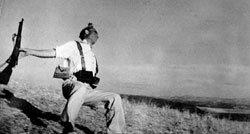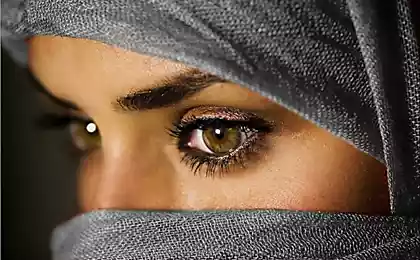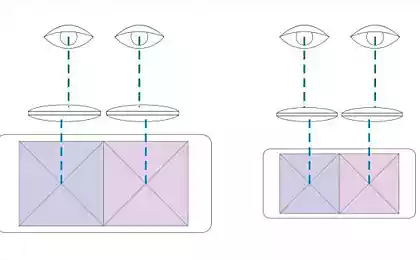964
Do not lie to my eyes!
Understanding of the truth of the picture story is greatly exaggerated, and dividing by the documentary and fictional, reportage and artistic photography is very conditional. In this case, it is not necessarily about the falsification, talking about the extent of our trust facsimiles, and that the line between reality and fiction in reportage photography is much thinner than we think. To create a great shot photographer is using the same methods as, for example, the author of the literary text: come up with story and character types, edit the resulting material, creates a spectacular header. After it can work editor who put the photo in the right context, and censor, which removes it from unnecessary details and characters. All is in order. There are extreme cases: reportage frame is proving to be entirely staging or taken from the film. A picture that became a symbol of time, can be made entirely in another. Not to mention the fact that many unfortunate events could not happen will not happen next photographer. Here are a few examples.
Death Confederate

150 years ago, the appearance of photographs, as later film, caused an unprecedented surge of enthusiasm. For the first time by technical means able to capture the world as it is! Particularly impressive pictures taken during the American Civil War. Journalists were delighted with the way the authors of the first "brought us the tragedy of war", and not only its front side, practically "putting the bodies of soldiers on both sides of our very doorstep" (many of the photos and now seem to be too naturalistic). Scottish-born American Alexander Gardner founded the photo agency, and after the war has published two volumes of his own and other people's war photographs, which became a classic of the genre. Later, however, it turned out that many photographs - production. For his most famous picture "The last refuge arrow troops Confederation" (July 1863) Gardner dragged the corpse of a soldier from the battlefield to the stone wall for greater artistic expression. If you look closely, under the head of a soldier can discern the blanket on which lay the body when it was carried. The same body can be seen in other photos Gardner in a completely different position.
The shooting of the Communards

The first time the technique of shooting was very imperfect - because of the cumbersome cameras and necessary long exposure (open the lens - wait a few minutes, and even much longer) photographers could not do snapshots. Instead of military operations themselves, they were forced to remove the effects of war, instead of people on the streets - the building. That defeat of the Paris Commune shoot, of course, no one has. A few years later it was decided to simply remove the dramatization. Looking closely to the pictures, "Shooting the Communards of Paris Commune" (1870s) more closely, we certainly see that this is a pure theater: people pose unnatural, the point at which the survey was made, hardly would allow the photographer to stay alive. Moreover, the picture clearly assembled from multiple frames. When a picture is published for the first time, was a phenomenal success - at the turn of XIX-XX centuries, viewers still could not distinguish from the original staged shots. However, to recognize a fake and could not be in a hundred years. In 1971, to celebrate the centenary of the Paris Commune German magazine Stern put a few of these photographs as archival documents era.
Storming of the Winter-1

About "Winter Storm" in the book by Leonid Volkov, Lanita "History is written by the lens" (1971) tells the epic story and almost given memories photographer Ivan Kobozeva. Kobozev allegedly carried out important mission - to collect information on the location of the enemy "in the interests of the Bolshevik Party." It was then that he made his historical frame - just at night from 25 to 26 October 1917. Half a century frame shown in the enlarged view of the exhibition at the Exhibition Center "50 years of the October Revolution." But as recently proved the American researcher David King, no fixing storming of the Winter or on film or on the film was not. The photograph captures the same play outdoors, which is set annually after the revolution famous artists Yuri Annenkov and Nathan Altman.
Storming of the Winter-2

A shot from the feature film "October" by Sergei Eisenstein in 1927 repeatedly replicated in the form of posters and illustrations in textbooks. The famous photographer Alexander Rodchenko in the same 1927 saw the picture in the Museum of the Revolution, and was very surprised that we never signed that he staged. "Oh, all consider it a document used to," - the minister said lazily.
Another example of how an episode from the movie becomes photodocuments era: boarded up wooden door with the inscription "The regional committee is closed. All went to the front. " Great shot repeatedly played back in the history books and textbooks as a photo document of the Civil War in 1918 or 1919. This is actually a picture of the documentary feature film "The Story of our happiness." The picture was removed in 1938 for the 20th anniversary of the Komsomol.
Combat

TASS photojournalist Max Alpert made a lot of great stories from World War II. His "Combat" in 1942 spread around the world, published on the front pages of newspapers and magazine covers. Since it involves a lot of curious things - all sorts of people learned in a picture of their relatives, countrymen and fellow soldiers, saying that in the heat of battle Alpert just do not have time to write the name of the person in the photograph. However, then some have questioned the fact that the picture was taken in 1942. According to the currently popular version, the picture was taken at the exercises before the war.
Mount

During the war photojournalist Dmitry Baltermants was sent to remove the Kerch landing Soviet assault. Troopers eventually not landed, but the photographer saw a terrible picture: on the field among the hundreds of corpses went distraught people - the Nazis shot here several thousand civilians. Baltermants shot a plurality of frames. Later, "Woe" became one of the symbols of the war and is now perhaps the most expensive photograph of Soviet writers of the period (according to preliminary estimates Sotheby`s, $ 3-15 thousand.). But the picture got such a response immediately. Baltermants himself, worked with his archive, never took it for personal exhibitions: Photo not conform to the ideas of how it should look like a mountain. In the 1960s, arrived in Moscow famous Italian photographer Cayo Garruba. He prepared the exhibition "What is man," and found a forgotten shoot. Together with Baltermantsa he invented expressive title - "Woe." Baltermants also worked on a photo - slammed a brighter sky. As a result, was named best picture at the exhibition, has received a lot of prizes. In Russia, it was shown for the first time only in 1975 on the occasion of the 30th anniversary of the Victory.
Banner over the Reichstag

Photograph the hoisting the flag over the Reichstag on the night of April 30 to May 1, 1945 could not be anyone. Later, at least six photographers to make the story on "Banner over the Reichstag" - at different times and in different places.
He made the first shot Victor Temin, it published in the newspaper "Pravda". Photographer persuaded to fly military pilot, risking their lives, about the Reichstag (around the middle of the battle). According to legend, for a picture Temina almost shot: to take a photo in Moscow, he allegedly took the plane without permission of Zhukov. Evil tongues, however, argued that the banner turned out so small that Pravdinsky artists had to finish it.
Another famous picture belongs Anatoly Morozov. In his stories, made their way to the Reichstag, he saw a tired, grubby people. Upon learning that the flag is set sergeants Egorov and Kantariya, he got them on the roof and under the cover of machine gunners took a few shots, use one of the five actual banners, handed the soldiers for hoisting over the Reichstag.

But in the picture Eugene Chaldea staging is all clean. For example, the flag Khaldey carried with him polvoyny. According to the stories of colleagues, it was a banner profkomovskoe any organization, big, beautiful, with a star, hammer and sickle. Place for pictures and a specially selected - if you look closely, Morozovsk Egorov and Kantariya hoisting the flag at the top of the Reichstag, while the Chaldean soldiers stand in one of the side niches. Still famous was the least truthful, most staging a picture - just because he was the most laid out in composition, spectacle and photographic winnings.
Death Republican

Picture "Death of a Republican" one of the founders of the famous photo agency Magnum Robert Capa called, perhaps, the most lively debate in the history of photography. In August 1936, a few weeks after the start of the Spanish Civil War, anti-fascist Capa joined the Republican forces and, moving with them, photographing the event. His most famous photograph was first published September 23, 1936 in the French magazine Vu, and then reprinted July 12, 1937 in Life.
In 1975, British journalist Phillip Knightley has published a book in which the correspondent of the London Daily Express newspaper Gelleher told the following story. Once, when a couple of days there was no military action, Robert Capa soldiers asked him to play for a few scenes from the nearest trenches. It was they who were captured on film. However, it soon became clear that Gelleher Capa and in 1936 fought on opposite sides, and hardly ever met before 1939.
Finally, thanks to a long and painstaking research Richard Velanio able to establish that the photograph depicted Federico Borrell García, really died Sept. 5, 1936. However, clearing the Capa photograph of suspected falsification, Whelan set a very different problem - ethical. Perhaps if it were not for Robert Capa, the soldier would have remained alive. Apparently, Borrell and others climbed out of the trench and began to pose Cape. The enemy opened fire. Borrell was killed and Capa photographed this moment.
Vietnam War
Photo Nick Uta "by napalm girl" (1972) won the Pulitzer Prize and the Prize World Press Photo, becoming a symbol of the horrors of war. The author called "the new Goya." For a long time the photo was used as a charge against the "US military" in Vietnam. The episode with the girl running occurred at a time when the South Vietnamese pilots dropped a few bombs on the village near Saigon 8 June 1972. The event was shot on photo and movie cameras, several journalists. Suddenly they heard a child's cry and saw the running of children who drove a group of soldiers. One of the girls from the horror ripped off all my clothes. Nick Ut photographed running children and became famous photograph. The girl survived and later emigrated to Canada. However, then in view photos and keep the film had the impression that children are especially driven to sitting on the roadside correspondents. Perhaps this episode would not have happened if he had not been appreciative audience. The same is said and about other famous photograph - a picture of Eddie Adams' shooting Viet Cong "(1968).
Kopirayteg
Death Confederate

150 years ago, the appearance of photographs, as later film, caused an unprecedented surge of enthusiasm. For the first time by technical means able to capture the world as it is! Particularly impressive pictures taken during the American Civil War. Journalists were delighted with the way the authors of the first "brought us the tragedy of war", and not only its front side, practically "putting the bodies of soldiers on both sides of our very doorstep" (many of the photos and now seem to be too naturalistic). Scottish-born American Alexander Gardner founded the photo agency, and after the war has published two volumes of his own and other people's war photographs, which became a classic of the genre. Later, however, it turned out that many photographs - production. For his most famous picture "The last refuge arrow troops Confederation" (July 1863) Gardner dragged the corpse of a soldier from the battlefield to the stone wall for greater artistic expression. If you look closely, under the head of a soldier can discern the blanket on which lay the body when it was carried. The same body can be seen in other photos Gardner in a completely different position.
The shooting of the Communards

The first time the technique of shooting was very imperfect - because of the cumbersome cameras and necessary long exposure (open the lens - wait a few minutes, and even much longer) photographers could not do snapshots. Instead of military operations themselves, they were forced to remove the effects of war, instead of people on the streets - the building. That defeat of the Paris Commune shoot, of course, no one has. A few years later it was decided to simply remove the dramatization. Looking closely to the pictures, "Shooting the Communards of Paris Commune" (1870s) more closely, we certainly see that this is a pure theater: people pose unnatural, the point at which the survey was made, hardly would allow the photographer to stay alive. Moreover, the picture clearly assembled from multiple frames. When a picture is published for the first time, was a phenomenal success - at the turn of XIX-XX centuries, viewers still could not distinguish from the original staged shots. However, to recognize a fake and could not be in a hundred years. In 1971, to celebrate the centenary of the Paris Commune German magazine Stern put a few of these photographs as archival documents era.
Storming of the Winter-1

About "Winter Storm" in the book by Leonid Volkov, Lanita "History is written by the lens" (1971) tells the epic story and almost given memories photographer Ivan Kobozeva. Kobozev allegedly carried out important mission - to collect information on the location of the enemy "in the interests of the Bolshevik Party." It was then that he made his historical frame - just at night from 25 to 26 October 1917. Half a century frame shown in the enlarged view of the exhibition at the Exhibition Center "50 years of the October Revolution." But as recently proved the American researcher David King, no fixing storming of the Winter or on film or on the film was not. The photograph captures the same play outdoors, which is set annually after the revolution famous artists Yuri Annenkov and Nathan Altman.
Storming of the Winter-2

A shot from the feature film "October" by Sergei Eisenstein in 1927 repeatedly replicated in the form of posters and illustrations in textbooks. The famous photographer Alexander Rodchenko in the same 1927 saw the picture in the Museum of the Revolution, and was very surprised that we never signed that he staged. "Oh, all consider it a document used to," - the minister said lazily.
Another example of how an episode from the movie becomes photodocuments era: boarded up wooden door with the inscription "The regional committee is closed. All went to the front. " Great shot repeatedly played back in the history books and textbooks as a photo document of the Civil War in 1918 or 1919. This is actually a picture of the documentary feature film "The Story of our happiness." The picture was removed in 1938 for the 20th anniversary of the Komsomol.
Combat

TASS photojournalist Max Alpert made a lot of great stories from World War II. His "Combat" in 1942 spread around the world, published on the front pages of newspapers and magazine covers. Since it involves a lot of curious things - all sorts of people learned in a picture of their relatives, countrymen and fellow soldiers, saying that in the heat of battle Alpert just do not have time to write the name of the person in the photograph. However, then some have questioned the fact that the picture was taken in 1942. According to the currently popular version, the picture was taken at the exercises before the war.
Mount

During the war photojournalist Dmitry Baltermants was sent to remove the Kerch landing Soviet assault. Troopers eventually not landed, but the photographer saw a terrible picture: on the field among the hundreds of corpses went distraught people - the Nazis shot here several thousand civilians. Baltermants shot a plurality of frames. Later, "Woe" became one of the symbols of the war and is now perhaps the most expensive photograph of Soviet writers of the period (according to preliminary estimates Sotheby`s, $ 3-15 thousand.). But the picture got such a response immediately. Baltermants himself, worked with his archive, never took it for personal exhibitions: Photo not conform to the ideas of how it should look like a mountain. In the 1960s, arrived in Moscow famous Italian photographer Cayo Garruba. He prepared the exhibition "What is man," and found a forgotten shoot. Together with Baltermantsa he invented expressive title - "Woe." Baltermants also worked on a photo - slammed a brighter sky. As a result, was named best picture at the exhibition, has received a lot of prizes. In Russia, it was shown for the first time only in 1975 on the occasion of the 30th anniversary of the Victory.
Banner over the Reichstag

Photograph the hoisting the flag over the Reichstag on the night of April 30 to May 1, 1945 could not be anyone. Later, at least six photographers to make the story on "Banner over the Reichstag" - at different times and in different places.
He made the first shot Victor Temin, it published in the newspaper "Pravda". Photographer persuaded to fly military pilot, risking their lives, about the Reichstag (around the middle of the battle). According to legend, for a picture Temina almost shot: to take a photo in Moscow, he allegedly took the plane without permission of Zhukov. Evil tongues, however, argued that the banner turned out so small that Pravdinsky artists had to finish it.
Another famous picture belongs Anatoly Morozov. In his stories, made their way to the Reichstag, he saw a tired, grubby people. Upon learning that the flag is set sergeants Egorov and Kantariya, he got them on the roof and under the cover of machine gunners took a few shots, use one of the five actual banners, handed the soldiers for hoisting over the Reichstag.

But in the picture Eugene Chaldea staging is all clean. For example, the flag Khaldey carried with him polvoyny. According to the stories of colleagues, it was a banner profkomovskoe any organization, big, beautiful, with a star, hammer and sickle. Place for pictures and a specially selected - if you look closely, Morozovsk Egorov and Kantariya hoisting the flag at the top of the Reichstag, while the Chaldean soldiers stand in one of the side niches. Still famous was the least truthful, most staging a picture - just because he was the most laid out in composition, spectacle and photographic winnings.
Death Republican

Picture "Death of a Republican" one of the founders of the famous photo agency Magnum Robert Capa called, perhaps, the most lively debate in the history of photography. In August 1936, a few weeks after the start of the Spanish Civil War, anti-fascist Capa joined the Republican forces and, moving with them, photographing the event. His most famous photograph was first published September 23, 1936 in the French magazine Vu, and then reprinted July 12, 1937 in Life.
In 1975, British journalist Phillip Knightley has published a book in which the correspondent of the London Daily Express newspaper Gelleher told the following story. Once, when a couple of days there was no military action, Robert Capa soldiers asked him to play for a few scenes from the nearest trenches. It was they who were captured on film. However, it soon became clear that Gelleher Capa and in 1936 fought on opposite sides, and hardly ever met before 1939.
Finally, thanks to a long and painstaking research Richard Velanio able to establish that the photograph depicted Federico Borrell García, really died Sept. 5, 1936. However, clearing the Capa photograph of suspected falsification, Whelan set a very different problem - ethical. Perhaps if it were not for Robert Capa, the soldier would have remained alive. Apparently, Borrell and others climbed out of the trench and began to pose Cape. The enemy opened fire. Borrell was killed and Capa photographed this moment.
Vietnam War
Photo Nick Uta "by napalm girl" (1972) won the Pulitzer Prize and the Prize World Press Photo, becoming a symbol of the horrors of war. The author called "the new Goya." For a long time the photo was used as a charge against the "US military" in Vietnam. The episode with the girl running occurred at a time when the South Vietnamese pilots dropped a few bombs on the village near Saigon 8 June 1972. The event was shot on photo and movie cameras, several journalists. Suddenly they heard a child's cry and saw the running of children who drove a group of soldiers. One of the girls from the horror ripped off all my clothes. Nick Ut photographed running children and became famous photograph. The girl survived and later emigrated to Canada. However, then in view photos and keep the film had the impression that children are especially driven to sitting on the roadside correspondents. Perhaps this episode would not have happened if he had not been appreciative audience. The same is said and about other famous photograph - a picture of Eddie Adams' shooting Viet Cong "(1968).
Kopirayteg






















